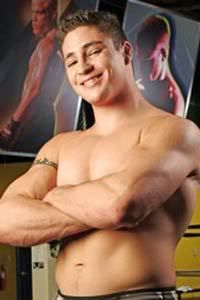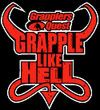Sanchez’s Keys to 20 Straight Wins

By Michael DiSanto
Name the only current UFC fighter riding a 20-fight professional winning streak.
Chuck Liddell?
No.
Matt Hughes?
No.
Georges St-Pierre? Tito Ortiz? B.J. Penn? Randy Couture?
No. No. No. No.
Okay, that is a bit of a trick question. The UFC is so unpredictable that nobody on the promotion’s roster can boast a current run of 20 consecutive wins.
One man, however, stands on the doorstep of just such a feat. On April 7, Diego Sanchez puts his perfect 19-0 record on the line against bitter rival Josh Koscheck. It is a long-awaited rematch between two bitter rivals, one that UFC fans have been clamoring over since they first squared off in the Octagon in a late-2004 exhibition bout on “The Ultimate Fighter.”
Sanchez was able to pull out a hotly contested split decision victory the first time around. What can he do to find victory one more time and extend his impressive winning streak to an almost-unheard of 20 straight?
Back him up
Sanchez is the embodiment of the stereotypical Mexican-American fighter – aggressive to a fault, preferring to thrill the crowd with an all-out war rather than taking a more conservative, calculated approach to fights. While that sounds like somewhat of a criticism, it is a tremendous compliment because that is the formula that turns fighters into superstars.
Sometimes, however, fighting with unchecked aggression is a bad thing, particularly when facing counter strikers, such as Chuck Liddell. But Sanchez isn’t facing a counter striker at UFC 69. Instead, he is fighting a physical monster in Koscheck. So, it is a big strength for Sanchez because this fight is about asserting physical dominance and breaking the other man’s will as much as it is a war of technique.
There is little doubt that Koscheck will come out looking to get the takedown. But just as with each of his previous fights, he will first try to establish his standup game. That is even more likely in a bout where very real bad blood exists, like this one.
Sanchez, therefore, will have an opportunity to make a statement early. He can put his opponent on the defensive by stalking Koscheck aggressively from the opening bell, cutting off the cage and looking to engage on the feet. Such pressure will cause Koscheck to circle out laterally or even back straight up, which reduces the effectiveness of his takedowns and puts Sanchez is control – maybe not physically but certainly mentally. And that is the first step to securing victory.
Forget the jab, unload hooks and uppercuts
Because Sanchez stands with his shoulders more squarely to his target than a traditional boxer, fighting behind the jab is a waste of time, particularly if he has his opponent circling or retreating. He should instead come out throwing power shots, trying to reach Koscheck’s chin. The AKA-trained Koscheck has improved his standup exponentially since the last time these two met, but he still has a tendency to fight with his chin up, rather than tucked into his chest, during exchanges.
If Sanchez can force a standup exchange, he doesn’t have to land more shots. He doesn’t even have to win the exchange from a point perspective. All he has to do is take a suggestion from AT&T and “reach out and touch someone.”
If you doubt Sanchez’s punching power, just watch his bout with Joe Riggs. A single right hook put the “Diesel” down. If you need further evidence, check out photos of Karo Parisyan’s face after he traded blows with Sanchez.
One shot. That is all it takes.
Sanchez believes it. His handlers believe it. If he can force a standup exchange, throw caution to the wind and throw power shots in bunches, he might just make Koscheck believe it in the form of a knockout.
Success on the feet is the road to glory
It has been said many times before, but the best way to beat a wrestler is to put him on his back. It is the whole “wrestlers are like cockroaches; and if you put a cockroach on its back, it dies” theory.
The question, however, is how does Sanchez score a takedown against a far superior wrestler?
The short answer is by punching him in the face – repeatedly.
The world knows that Sanchez is not a polished striker. Sure, he has improved his striking from his close friendship with former Olympic boxer Francisco “Panchito” Bojado. But he isn’t going to win many fights by impersonating Liddell.
Nevertheless, establishing his standup game is particularly important in this fight because of the wrestling deficit. Once he starts landing punches, Sanchez will force Koscheck to focus more on defending strikes than worrying about takedowns. That opens the door for Sanchez to shoot for a double-leg and put Koscheck on his back.
Forget caution, ground-and-pound like there is no tomorrow
When Sanchez finally gets the takedown, it is time to go for broke. Whereas Koscheck has a massive wrestling advantage, Sanchez holds an equal advantage in the jiu-jitsu realm. That means he isn’t as concerned as other fighters about getting swept. As a result, Sanchez is free to do what he does best on the ground – ground and pound like there is no tomorrow.
With all due respect to Matt Hughes, Diego “Nightmare” Sanchez has the most fearsome ground and pound in the 170-lb division.
He doesn’t pitter patter from the top. He doesn’t throw the occasional elbow with the hopes of opening a cheap cut. And he certainly doesn’t lay and pray.
No.
Diego Sanchez throws punches and elbows with a sense of hatred. He throws shots designed to cause as much physical damage as possible – shots that break bones.
Koscheck may believe that he can outwrestle or outstrike Sanchez, but he knows damn well that he does not want to find himself on his back defending punches and elbows because that is an almost-certain recipe for a short night in the Octagon and a long night with an ice pack.
As a result, the minute Koscheck finds himself trying to defend from his guard, that little green monster we call doubt will rear its ugly head. When Sanchez opens up his attack, that doubt may turn into panic or desperation. Both panic and desperation lead to mistakes, such as giving up one’s back without defending against the rear-naked choke, a la Frank Trigg versus both Hughes and Georges St-Pierre.
Some may think that is bad advice, particularly against a guy with tremendous sweeps and escapes. But the fact remains that Sanchez doesn’t mind throwing hands. He certainly doesn’t mind relying on his slick jiu-jitsu and fighting from his guard. And he doesn’t mind turning this into a gut-check war. So, there is no need to play conservative once the fight hits the ground.
At the end of the day, Sanchez is more than a 2-to-1 favorite for a reason. The undefeated fighter hasn’t yet learned how to lose. He can beat guys by knockout, submission or sustained beating leading to a judges’ decision. And if he can find a way to turn this into a war and test Koscheck’s chin or put the wrestler on his back and pound away, he won’t learn how to lose on April 7.






















No comments:
Post a Comment